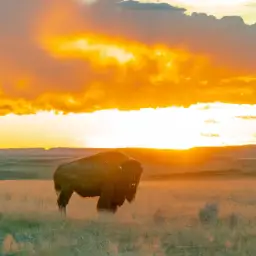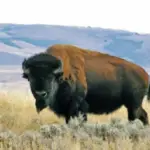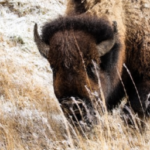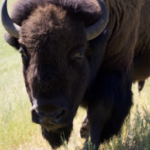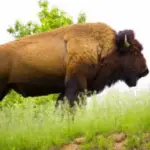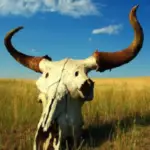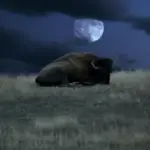Imagine if you could quench your curiosity and learn the exact number of bison that exist in the world. Look no further, because the answer is finally here with the revolutionary product, “How Many Bison Are In The World.” This innovative tool provides you with the most accurate and up-to-date information on the global bison population, allowing you to satisfy your thirst for knowledge and impress your friends with fascinating facts. Say goodbye to uncertainty and embrace the power of knowledge with “How Many Bison Are In The World.”
Global Bison Population
Current number of bison worldwide
The global bison population is estimated to be around 500,000 individuals. While this number may seem significant, it is important to note that it is merely a fraction of the historical population size. Bison, also known as buffalo, once roamed the vast grasslands of North America in the millions. However, due to overhunting and habitat destruction, their numbers declined drastically, pushing them to the brink of extinction. Fortunately, concerted conservation efforts have helped stabilize their population in recent years.
Recent trends in bison population
In recent years, the bison population has shown signs of recovery. Conservation efforts and reintroduction programs have played a significant role in this positive trend. Many countries, including the United States, Canada, and several European nations, have made substantial efforts to protect and restore bison populations. These initiatives have led to a gradual increase in the global bison population, giving hope for the future of these magnificent creatures.
Factors affecting global bison population
Despite the increasing trend in bison populations, there are several factors that continue to impact their numbers. Habitat loss and fragmentation remain significant threats to bison populations worldwide. As human settlements expand and agricultural activities intensify, bison habitats are being diminished, leading to the loss of critical feeding and breeding grounds. Additionally, climate change poses challenges to bison as they rely on specific habitat conditions for survival. Rising temperatures, altered rainfall patterns, and increased frequency of extreme weather events can disrupt their food availability and reproductive cycles.
Distribution of Bison Globally
Bison in North America
North America is the native homeland of bison, and it continues to be home to the largest populations. The United States has the most substantial number of bison, estimated at over 350,000 individuals. They can be found in various states, including Montana, Wyoming, and South Dakota, where large-scale conservation efforts have helped restore their populations. In addition, Canada also supports a significant number of bison, with approximately 120,000 individuals spread across several provinces.
Bison in Europe
Europe is home to the European bison, also known as wisent. Poland is the primary stronghold for this species, with around 1,200 individuals living in Białowieża Forest and other protected areas. Efforts in Poland have focused on preserving and expanding the wisent population within its historical range. Additionally, other European countries, such as Belarus, Lithuania, and Russia, have started reintroduction programs to restore the presence of the European bison in their landscapes.
Bison in other parts of the world
Bison populations outside of North America and Europe are relatively small. In Mexico, efforts are being made to protect and increase the population of the North American bison subspecies, known as the American bison or buffalo. The national parks and reserves in Mexico provide sanctuary for these iconic animals. Although still a small population, these bison serve as a reminder of their historical presence in the region. In other parts of the world, there are limited populations kept in captivity in zoos and reserves, contributing to conservation and education efforts.
North American Bison
Number of bison in United States
The United States is home to the largest number of bison worldwide, with an estimated population of over 350,000 individuals. Various states have implemented bison restoration programs, promoting the conservation of these magnificent creatures. National parks, such as Yellowstone and Badlands, have played a pivotal role in providing protected habitats for bison and supporting their recovery.
Number of bison in Canada
Canada, too, has made significant strides in conserving bison populations. With around 120,000 individuals, Canada’s bison population is a vital contributor to the global bison population. Several national parks, including Wood Buffalo National Park, Canadian Rockies Hot Springs, and Elk Island National Park, have been instrumental in protecting and managing bison populations.
Number of bison in Mexico
While the population of bison in Mexico is smaller compared to the United States and Canada, conservation efforts are underway to protect this iconic species. Various protected areas, including the El Carmen and Janos Biosphere Reserves, provide crucial habitats for the North American bison subspecies. These conservation efforts aim to ensure the long-term survival of bison in Mexico and maintain their ecological importance in the region.
European Bison or Wisent
Number of bison in Poland
Poland is the stronghold for the European bison, also known as wisent. With approximately 1,200 individuals, Poland’s efforts have been crucial in preserving this iconic species. Wisent populations are concentrated in Białowieża Forest, which spans parts of Poland and Belarus. Strict protection measures and habitat restoration initiatives have helped stabilize the population and expand their range within this primeval forest ecosystem.
Number of bison in other European countries
Several other European countries have made significant efforts to reintroduce the European bison to their native landscapes. Countries such as Belarus, Lithuania, and Russia have established breeding programs and reintroduction projects to restore the wisent population. In total, there are around 5,800 European bison individuals living in protected areas throughout Europe, marking a remarkable conservation success story.
Conservation efforts for European bison
Conservation of the European bison involves collaboration between multiple countries and organizations. The European Bison Conservation Center, based in Poland, coordinates efforts to manage and preserve the wisent populations. Conservation programs focus on habitat restoration, genetic diversity, and reintroduction initiatives. These efforts aim to secure the long-term survival of the European bison and maintain its ecological significance in its natural habitats.
Classification of Bison
Description of the Bison species
Bison is a large mammal belonging to the Bovidae family, which also includes cattle, antelopes, and goats. They are herbivores with a significant muscular hump on their shoulders, a characteristic feature distinguishing them from other bovid species. Bison have a thick coat of fur, which helps insulate them in harsh climates. They are known for their distinctively shaped horns, which both males and females possess.
Differences between American Bison and European Bison
The two main species of bison are the American Bison (Bison bison) and the European Bison or wisent (Bison bonasus). American bison possess a larger and more robust build compared to their European counterparts. They have a characteristic shoulder hump and a shaggy mane.
European bison, on the other hand, are slightly smaller in size and have a different horn shape. Male European bison typically have thicker and more curved horns than their American counterparts. Furthermore, their genetic makeup differs, with the European bison exhibiting higher genetic diversity due to successful conservation efforts.
Understanding Bison subspecies
Within the American Bison species, several subspecies exist, each adapted to specific regions and habitats. Some of the most notable subspecies include the Plains Bison, Wood Bison, and Mexican Bison. Each subspecies has unique characteristics and can be found in different parts of North America. Understanding these subspecies is crucial for effective conservation strategies and preserving their genetic diversity.
Bison Habitat
Typical habitats for Bison
Bison primarily inhabit grasslands, prairies, and open woodlands. They require access to abundant vegetation for grazing and access to water sources for drinking. These large herbivores have high nutritional needs, and their habitat should provide ample grazing opportunities throughout the year, especially during the winter months when other food sources are scarce.
Changes in Bison habitat over time
Historically, bison inhabited vast stretches of North America, from the Great Plains to the East Coast. However, habitat loss and fragmentation due to human activities, such as agriculture and urbanization, have significantly impacted their range. The conversion of natural grasslands into farmlands and the restriction of their movement by fences have limited their access to suitable habitats. As a result, bison populations have become isolated, making them more vulnerable to various threats.
Impact of habitat loss on Bison population
Habitat loss and degradation have been key contributors to the decline of bison populations. As their habitats shrink, bison populations become confined to smaller areas, reducing their ability to find sufficient food and water resources. Additionally, fragmented habitats hinder their migration patterns, which are essential for genetic diversity and population dynamics. Therefore, protecting and restoring suitable habitats is crucial for the long-term conservation of bison.
Bison Conservation
Current status of bison conservation
The conservation status of bison varies across different regions and subspecies. While the global bison population has shown signs of recovery, several subspecies remain classified as endangered or vulnerable. Conservation efforts have focused on restoring and expanding populations, enhancing genetic diversity, and mitigating threats to their habitats. It is crucial to continue monitoring and implementing proactive conservation measures to ensure the long-term survival of bison populations worldwide.
Role of national parks and reserves in bison conservation
National parks and reserves have played a vital role in bison conservation. These protected areas provide safe havens for bison populations, allowing them to thrive and fulfill their ecological roles. National parks such as Yellowstone and Wood Buffalo have served as strongholds for bison, serving as models for successful conservation practices. They offer large, undisturbed habitats and protection from human activities, enabling bison populations to grow and maintain genetic diversity.
Impact of conservation programs on bison population
Conservation programs have had a positive impact on bison populations. Through captive breeding, reintroduction initiatives, and habitat restoration, bison populations have shown signs of recovery. These programs have increased the number of bison individuals, expanded their range, and enhanced genetic diversity. Additionally, public education and awareness campaigns have fostered a greater understanding and appreciation for bison, garnering support for their conservation.
Bison In Captivity
Number of bison in zoos and farms
In addition to wild populations, bison are also found in captivity worldwide. Zoos and farms play a role in bison conservation by serving as centers for education, research, and breeding programs. While the exact number is difficult to estimate, it is believed that thousands of bison are held in captivity, spread across various facilities and private farms. These captive populations contribute to genetic diversity and provide opportunities for studying these majestic animals up close.
Breeding programs in captivity
Breeding programs in captivity play a vital role in maintaining genetic diversity and supporting the conservation of bison populations. Managed breeding, also known as ex-situ conservation, ensures that captive populations represent the genetic diversity found in wild populations. This approach helps mitigate the risks associated with inbreeding and provides a safety net for the species in case of unforeseen events, such as disease outbreaks or natural disasters.
Impact of captivity on bison population growth
Captive breeding programs have contributed to the growth of bison populations, particularly for endangered subspecies and those with limited habitat availability. These programs allow for controlled breeding, ensuring the survival of individuals with valuable genetic traits. Furthermore, captive populations serve as potential sources for reintroduction efforts, reinforcing wild populations and maintaining overall species resilience.
Threats to Bison Population
Natural threats to bison
Bison populations face various natural threats that impact their survival. Severe weather events, such as droughts, blizzards, and wildfires, can result in food shortages and loss of habitat. Predators, including wolves and bears, can also pose a risk to bison, especially to vulnerable individuals such as calves or injured animals. Additionally, competition for resources among bison themselves can have an impact on population dynamics.
Human-induced threats to bison
Human activities continue to pose significant threats to bison populations. Habitat loss and fragmentation due to urbanization and agricultural expansion disrupt the availability of suitable grazing and breeding grounds. Illegal hunting and poaching also remain concerns, as there is demand for bison products such as meat, hides, and trophies. Collisions with vehicles and fencing are additional risks, often resulting in injuries and fatalities.
Disease-related threats to bison
Disease outbreaks among bison populations can have devastating effects. One of the most significant concerns is brucellosis, a bacterial infection that can cause reproductive issues in bison and other animals. The transmission of diseases between livestock and bison poses a considerable risk, as it can lead to population declines and impact the overall health of bison populations. Disease monitoring and management are critical for ensuring the long-term health and survival of bison.
What Is the Population of Bison in a Typical Bison Herd?
A typical group of bison call, also known as a herd, can consist of anywhere from 20 to 50 individuals. However, some herds have been known to reach up to a few hundred bison. The population of a herd can vary based on the availability of food and the size of the habitat.
The Role of Bison in Ecosystems
Bison’s ecological significance
Bison play a crucial role in shaping and maintaining healthy ecosystems. As large herbivores, they help control the growth of grasses and maintain open grasslands and meadows. By grazing, they improve the diversity and quality of plant species, promoting a mosaic of habitats and creating opportunities for other wildlife to thrive. Additionally, their grazing behavior stimulates seed dispersal and germination, contributing to the overall health and functioning of grassland ecosystems.
Consequences of bison population decline on ecosystems
The decline in bison populations has had profound impacts on ecosystems that rely on their presence. Without bison, grasslands can become overgrown and dominated by specific species, reducing biodiversity and altering the balance of the ecosystem. The absence of bison also affects other species that depend on them for food or use their grazing patterns for nesting or habitat creation. The restoration of bison populations is therefore vital for maintaining the ecological integrity of their habitats.
Efforts to restore bison to their former habitats
Efforts to restore bison to their former habitats have been underway for decades, and they continue to be a priority for conservation organizations and national governments. Through controlled reintroductions and habitat restoration, bison are being returned to landscapes where they once roamed in large numbers. These initiatives aim to reestablish natural ecological processes, promote biodiversity, and ensure the long-term survival of bison and the ecosystems they inhabit.
In conclusion, while the global bison population has made significant progress in recent years, there is still much work to be done. Protecting and restoring their habitats, managing population dynamics, and addressing threats are critical for securing the future of these iconic species. By embracing conservation efforts, supporting breeding programs, and raising awareness about the ecological significance of bison, we can ensure that these magnificent creatures continue to roam our world for generations to come.

